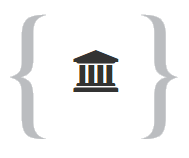Η Δυτική πτέρυγα του ανακτόρου υψωνόταν πιθανόν σε δυο ορόφους, οι οποίοι ήταν προσιτοί από την Κεντρική Αυλή. Στα δωμάτια του ισογείου, που βρισκόταν ελαφρώς χαμηλότερα από το επίπεδο της αυλής, κατέβαιναν λιγοστά σκαλοπάτια, ενώ μια μεγαλοπρεπής σκάλα ανόδου με κεντρικούς κίονες (σήμερα ανακατασκευασμένη από τον Evans) οδηγούσε στις αίθουσες του ορόφου (Piano Nobile). Τα ισόγεια διαμερίσματα χωρίζονταν σε δυο διακριτά λειτουργικά τμήματα από τον εσωτερικό μακρύ «Διάδρομο των Αποθηκών»: το δυτικότερο καταλάμβαναν οι Δυτικές Αποθήκες, ενώ στο ανατολικότερο στεγάζονταν τα σημαντικότερα ιερά και θησαυροφυλάκια του νέου ανακτόρου (1700-1450 π.Χ.). Δίπλα στο κλιμακοστάσιο ανόδου βρισκόταν το λεγόμενο «Συγκρότημα του Κεντρικού Ιερού», όπως το ονόμασε ο Evans. Η εξωτερική του πρόσοψη ήταν πιθανόν τριμερής, με ένα κεντρικό υπερυψωμένο τμήμα και δυο χαμηλότερα πλάγια, εκατέρωθεν. Η διαμόρφωση αυτή, που ονομάστηκε από τον ανασκαφέα «Τριμερές Ιερό», εικονίζεται σε μια μικρογραφική τοιχογραφία, που κοσμούσε αίθουσα του ορόφου και σήμερα εκτίθεται στο Αρχαιολογικό Μουσείο Ηρακλείου. Ακριβώς πίσω από την τριμερή πρόσοψη βρέθηκε μια από τις σημαντικότερες αποθέσεις ιερών αντικειμένων και τελετουργικού εξοπλισμού, μεταξύ των οποίων περιλαμβάνονται τα γνωστά αγαλματίδια της «Θεάς των όφεων» από φαγεντιανή. Στο εσωτερικό της πτέρυγας, επίσης, υπήρχαν δύο σκοτεινά δωμάτια («Δωμάτια των Κρυπτών»), με κεντρικό κτιστό πεσσό και ορθογώνιες δεξαμενές στο δάπεδο, που πιθανόν χρησίμευαν για μυστηριακές προσφορές υγρών σπονδών. Κατά την τελευταία περίοδο ζωής του ανακτόρου (1450-1380/1350 π.Χ.) στον όροφο και στα ισόγεια δωμάτια λειτουργούσαν τμήματα της γραφειοκρατικής διοίκησης. Εκατοντάδες πινακίδες της Γραμμικής Β΄ γραφής καταγράφουν τροχήλατα άρματα και άλογα, πολύτιμα αγγεία, αποστολές προσφορών ελαιολάδου και άλλων προϊόντων σε ιερά και θεότητες, εξειδικευμένο προσωπικό που απασχολούνταν στην παραγωγή υφασμάτων υψηλής ποιότητας, καθώς και εισπράξεις μεγάλων ποσοτήτων αρωματικών φυτών και αγροτικών προϊόντων από διάφορες περιοχές του νησιού.
(EL)
The West Wing of the Palace had possibly two storeys, which were accessed from the Central Court. A few steps led down to the ground-floor rooms, slightly below the level of the court, while an imposing staircase with central columns (now restored by Evans) led up to the halls on the first floor (the “Piano Nobile”). The rooms on the ground floor were divided into two separate functional areas by the long internal “Corridor of the Magazines”: the west side was occupied by the West Magazines, while the east side housed the most important shrines and treasuries of the New Palace (1700-1450 BC).
Next to the staircase ascending to the upper floor was the “Central Palace Sanctuary Area”, as Evans named it. The outer façade was probably in three parts, with a central raised section flanked by a lower section on either side. This arrangement, which the excavator named the “Tripartite Shrine”, is depicted in a miniature fresco that adorned a room on the upper floor and is now displayed in the Heraklion Archaeological Museum. Directly behind the tripartite façade was discovered one of the most important deposits of sacred objects and ritual equipment in the Palace, including the famous faience “Snake Goddess” statuettes. The wing also contained two dark private chambers (the “Pillar Crypts”), with a square central pillar and rectangular basins set into the floor, which were probably used for sacramental offerings of liquid libations.
During the last period of life of the Palace (1450-1380/1350 BC), offices of the bureaucratic administration were housed in the rooms of the ground and upper floors. Hundreds of Linear B tablets record wheeled chariots and horses, valuable vases, offerings of olive oil and other goods sent to sanctuaries and deities, specialised textile-makers producing high-quality cloth, and the arrival of large quantities of herbs and agricultural products from various parts of the island.
(EN)
 Institute of Computer Science - Foundation for Research and Technology Hellas.
Institute of Computer Science - Foundation for Research and Technology Hellas.



 Archaeological / prehistoric site
Archaeological / prehistoric site


